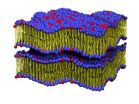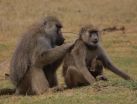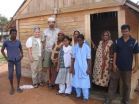Study shows that in baboons, as well as humans, social relationships matter
2014-09-10
(Press-News.org) Elizabeth Archie, Clare Booth Luce Assistant Professor in the Department of Biological Sciences at Notre Dame and colleagues used an incredibly rich data set on the social relationships of wild baboons which was collected on an almost daily basis, year-round, since 1984 by the Amboseli Baboon Research Project. The project, which Archie helps direct, is a long-term study of wild baboons that follows the lives of individual baboons, watching what they do and who they interact with.
"We can tell individual baboons apart by distinct features of their appearance, such as their fur color, the shape of their tail, or how they move," Archie said. "We especially focused on grooming interactions, which are a sign of social support in baboons. Baboons spend more time grooming their 'friends', and baboons with stronger grooming connections seem to live longer."
The Archie group's analysis of the data set found that females who were socially connected to both adult males and females lived longer than females with weak ties to one or both sexes.
The study begs the question of why to study female rather than male, or both sexes of baboons.
"We're hoping to do a similar study in males, but doing so is difficult because one of the key differences in the lives of male versus female baboons," Archie said, "Specifically, female baboons live in the same social group for their whole lives, so when they disappear from the group, we can be pretty certain that they died. This fact allows us to measure female life spans very accurately. However, male baboons often move repeatedly from one social group to another over the course of their adult life. Hence, if a male baboon disappears from the group, we can't be certain if he died or just moved away, which makes it difficult to measure male life spans."
Archie points out that the last few decades have brought a considerable interest in understanding how and when social relationships contribute to variation in lifespan. In humans, multiple studies have indicated that social integration and support predict both health and lifespan. However, comparable studies in non-human animals have been rare.
'There was one big challenge to conducting a study like ours, keeping the long-term field study going over several decades to collect the data we needed," Archie said. "Baboons in the wild can live for over 25 years, so we needed many years of data to accurately measure the baboons' life spans. Most research grants last only for three to five years, so the directors of the project have had to work hard to keep the field project funded. Special thanks goes to Susan Alberts at Duke and Jeanne Altmann at Princeton who have been working to support the project for many years."
Archie and her fellow researchers believe that their findings on social interconnectedness may be good news for baboons but for fellow species.
"I think the results are applicable to humans," Archie said. "Specifically, there have been a handful of studies that have shown that an animal's social connections can predict their longevity, including research on rats, dolphins and baboons. Our results help confirm this phenomenon in mammals and suggest it might be widely shared across several social species.
"In addition, we see very strong evidence that social relationships predict human lifespan. Across a range of circumstances, people who receive more social support tend to live longer than people who are socially isolated. Our results suggest that this phenomenon might be part of our shared biological history with other mammals.
INFORMATION:
The Archie group's paper appears in the Sept. 9th edition of the journal the Proceedings of the Royal Society B. The research was supported by funding from the National Science Foundation.
ELSE PRESS RELEASES FROM THIS DATE:
Teens' neural response to food commercials predicts future weight gain
2014-09-10
Children and adolescents see thousands of food commercials each year and most of them advertise junk foods high in sugar, fat and salt. Yet, we know almost nothing about how all of this food marketing impacts the brain, especially for teens. New research suggests that food commercials "get under the skin" of teens by activating reward regions when they are viewing ads for milk shakes, or burgers, or colas. The bad news for us is that this can result in weight gain and obesity.
In the first prospective longitudinal study to investigate neural response to unhealthy food ...
New research finds that smartphone apps are a useful tool for diet monitoring
2014-09-10
TEMPE, Ariz. (Sept. 10, 2014) - The ability and consistency in monitoring one's diet, but not dietary quality, improves with the use of smartphone applications, according to new research by Arizona State University health scientists published in the latest issue of the Journal of Nutrition Education and Behavior.
Researchers Christopher Wharton, Carol Johnston, Barbara Cunningham and Danielle Sterner at ASU's School of Nutrition and Health Promotion authored the study.
The study compared the effectiveness of a popular smartphone application called "Lose It" for dietary ...
Working during depression can offer health benefits to employees
2014-09-10
The collaborative study between the University Of Melbourne and the Menzies Research Institute at the University of Tasmania is the first to estimate the long-term costs and health outcomes of depression-related absence as compared to individuals who continue to work among employees with depression in Australia.
Lead researcher Dr Fiona Cocker from the Melbourne School of Population and Global Health said a greater understanding of the costs and consequences of both absenteeism and presenteeism would allow for more informed recommendations to be made to the benefit of ...
Researchers watch lipid molecules in motion
2014-09-10
Researchers from Göttingen in collaboration with colleagues from Augsburg have 'filmed' the movement of lipid molecules using an X-ray stroboscope at DESY. In the scientific journal Physical Review Letters, researchers lead by Professor Tim Salditt of the University of Göttingen report that their study offers new insights into the dynamics of biomolecules, which compose materials such as cell membranes. The cell membranes consist of a double layer of lipid molecules; the properties of the membranes are of great interest because they control which substances enter and exit ...
Pain tolerance levels between men and women are similar
2014-09-10
Resilience, a person's ability to overcome adverse circumstances, is the main quality associated with pain tolerance among patients and their adjustment to chronic pain. This is the result of a new study carried out at the University of Málaga that shows that the effect of gender on this ability is not as significant as originally thought.
Over the years a number of clinical trials have shown important gender differences with regard to susceptibility to pain through illness, effectiveness of medications and recovery after anaesthetic. Furthermore, these results coincide ...
UM study finds air pollution harmful to young brains
2014-09-10
MISSOULA, Mont. – Pollution in many cities threatens the brain development in children.
Findings by University of Montana Professor Dr. Lilian Calderón-Garcidueñas, MA, MD, Ph.D., and her team of researchers reveal that children living in megacities are at increased risk for brain inflammation and neurodegenerative changes, including Alzheimer's or Parkinson's disease.
Calderón-Garcidueñas' findings are detailed in a paper titled "Air pollution and children: Neural and tight junction antibodies and combustion metals, the role of barrier breakdown and brain ...
Lady baboons with guy pals live longer
2014-09-10
DURHAM, N.C. –- Numerous studies have linked social interaction to improved health and survival in humans, and new research confirms that the same is true for baboons.
A long-term study of more than 200 wild female baboons from the plains of southern Kenya finds that the most sociable females –- measured by how often they engaged in social grooming relative to their peers -- live two to three years longer than their socially isolated counterparts.
Socializing with males gave females an even bigger longevity boost than socializing with other females, the researchers ...
New study reconstructs mega-earthquakes timeline in Indian Ocean
2014-09-10
MIAMI – A new study on the frequency of past giant earthquakes in the Indian Ocean region shows that Sri Lanka, and much of the Indian Ocean, is affected by large tsunamis at highly variable intervals, from a few hundred to more than one thousand years. The findings suggest that the accumulation of stress in the region could generate as large, or even larger tsunamis than the one that resulted from the 2004 magnitude-9.2 Sumatra earthquake.
Researchers from the University of Miami (UM) Rosenstiel School of Marine and Atmospheric Science and the University of Peradeniya ...
Mystery solved: 'Sailing stones' of Death Valley seen in action for the first time
2014-09-10
Racetrack Playa is home to an enduring Death Valley mystery. Littered across the surface of this dry lake, also called a "playa," are hundreds of rocks – some weighing as much as 320 kilograms (700 pounds) – that seem to have been dragged across the ground, leaving synchronized trails that can stretch for hundreds of meters.
What powerful force could be moving them? Researchers have investigated this question since the 1940s, but no one has seen the process in action – until now.
In a paper published in the journal PLOS ONE on Aug. 27, a team led by Scripps Institution ...
UC San Diego researchers build first 500 GHz photon switch
2014-09-10
The work took nearly four years to complete and it opens a fundamentally new direction in photonics – with far-reaching potential consequences for the control of photons in optical fiber channels.
Researchers at the University of California, San Diego have built the first 500 Gigahertz (GHz) photon switch. "Our switch is more than an order of magnitude faster than any previously published result to date," said UC San Diego electrical and computer engineering professor Stojan Radic. "That exceeds the speed of the fastest lightwave information channels in use today."
According ...





